Implementing Healthcare Safety Standards in Emergency Departments
VerifiedAdded on 2019/11/14
|10
|2837
|172
Report
AI Summary
This report focuses on healthcare safety standards within emergency department settings, emphasizing the implementation of proactive strategies and systematic interventions. It addresses key areas such as infection control (utilizing aseptic techniques and antimicrobial interventions), medication safety (safe prescription and dispensing), and fall prevention. The report is structured into sections covering planning (topic, objectives, and audience), methodology (questionnaires), seeking feedback (interview schedule), and a comprehensive literature review. The literature review examines barriers to change in clinical practice (lack of evidence-based systems, group thought culture, and absence of electronic health records) and facilitators (understanding of roles, optimism, pre-configured patient goals, and effective feedback mechanisms). The report also analyzes the influence of these barriers and facilitators on healthcare changes for a patient, Mrs. Betty, and recommends customizing medical interventions based on individual needs while considering social networks and mental wellness. Finally, it highlights the importance of effective healthcare policies and conventions for improving patient outcomes.
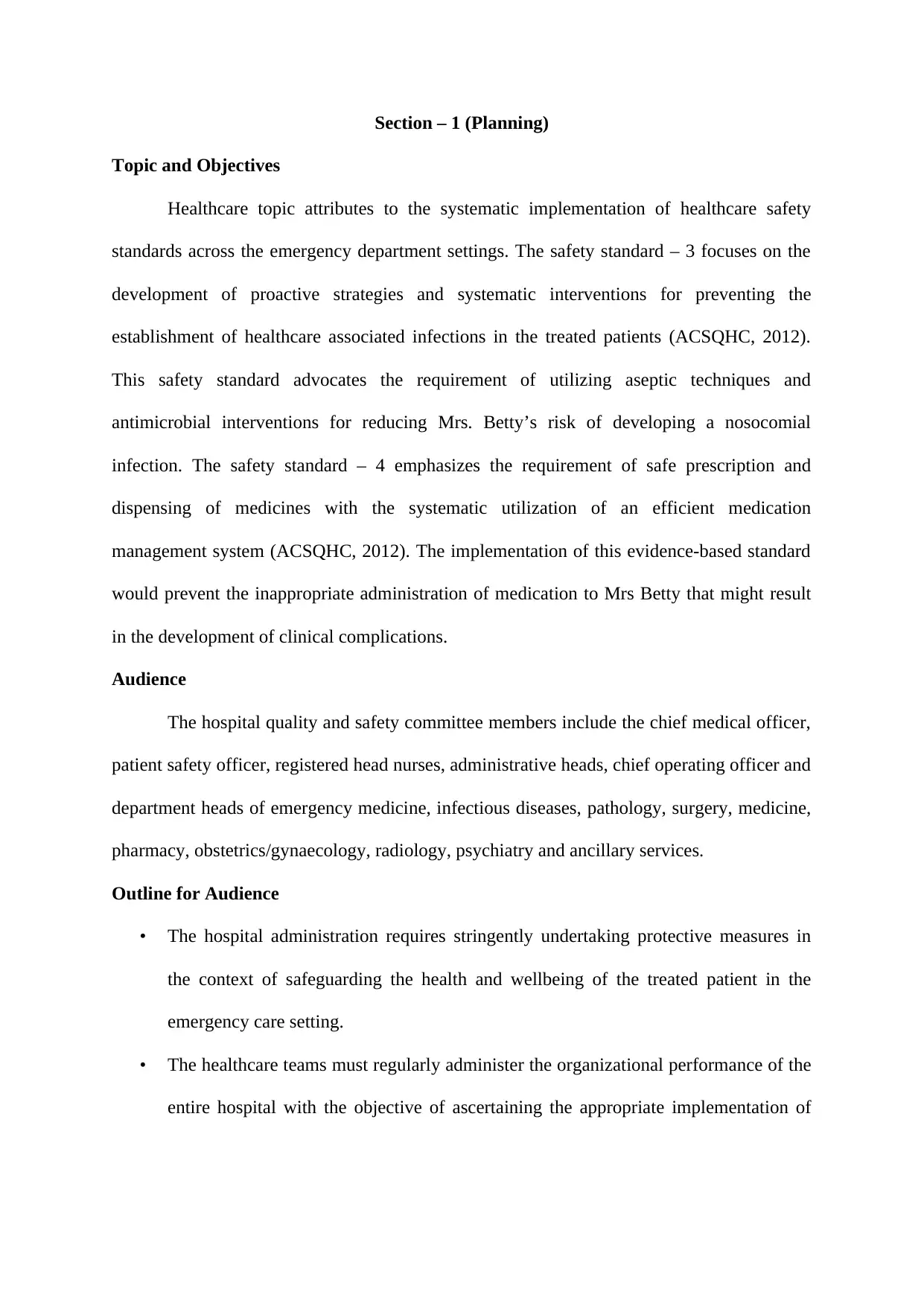
Section – 1 (Planning)
Topic and Objectives
Healthcare topic attributes to the systematic implementation of healthcare safety
standards across the emergency department settings. The safety standard – 3 focuses on the
development of proactive strategies and systematic interventions for preventing the
establishment of healthcare associated infections in the treated patients (ACSQHC, 2012).
This safety standard advocates the requirement of utilizing aseptic techniques and
antimicrobial interventions for reducing Mrs. Betty’s risk of developing a nosocomial
infection. The safety standard – 4 emphasizes the requirement of safe prescription and
dispensing of medicines with the systematic utilization of an efficient medication
management system (ACSQHC, 2012). The implementation of this evidence-based standard
would prevent the inappropriate administration of medication to Mrs Betty that might result
in the development of clinical complications.
Audience
The hospital quality and safety committee members include the chief medical officer,
patient safety officer, registered head nurses, administrative heads, chief operating officer and
department heads of emergency medicine, infectious diseases, pathology, surgery, medicine,
pharmacy, obstetrics/gynaecology, radiology, psychiatry and ancillary services.
Outline for Audience
• The hospital administration requires stringently undertaking protective measures in
the context of safeguarding the health and wellbeing of the treated patient in the
emergency care setting.
• The healthcare teams must regularly administer the organizational performance of the
entire hospital with the objective of ascertaining the appropriate implementation of
Topic and Objectives
Healthcare topic attributes to the systematic implementation of healthcare safety
standards across the emergency department settings. The safety standard – 3 focuses on the
development of proactive strategies and systematic interventions for preventing the
establishment of healthcare associated infections in the treated patients (ACSQHC, 2012).
This safety standard advocates the requirement of utilizing aseptic techniques and
antimicrobial interventions for reducing Mrs. Betty’s risk of developing a nosocomial
infection. The safety standard – 4 emphasizes the requirement of safe prescription and
dispensing of medicines with the systematic utilization of an efficient medication
management system (ACSQHC, 2012). The implementation of this evidence-based standard
would prevent the inappropriate administration of medication to Mrs Betty that might result
in the development of clinical complications.
Audience
The hospital quality and safety committee members include the chief medical officer,
patient safety officer, registered head nurses, administrative heads, chief operating officer and
department heads of emergency medicine, infectious diseases, pathology, surgery, medicine,
pharmacy, obstetrics/gynaecology, radiology, psychiatry and ancillary services.
Outline for Audience
• The hospital administration requires stringently undertaking protective measures in
the context of safeguarding the health and wellbeing of the treated patient in the
emergency care setting.
• The healthcare teams must regularly administer the organizational performance of the
entire hospital with the objective of ascertaining the appropriate implementation of
Paraphrase This Document
Need a fresh take? Get an instant paraphrase of this document with our AI Paraphraser
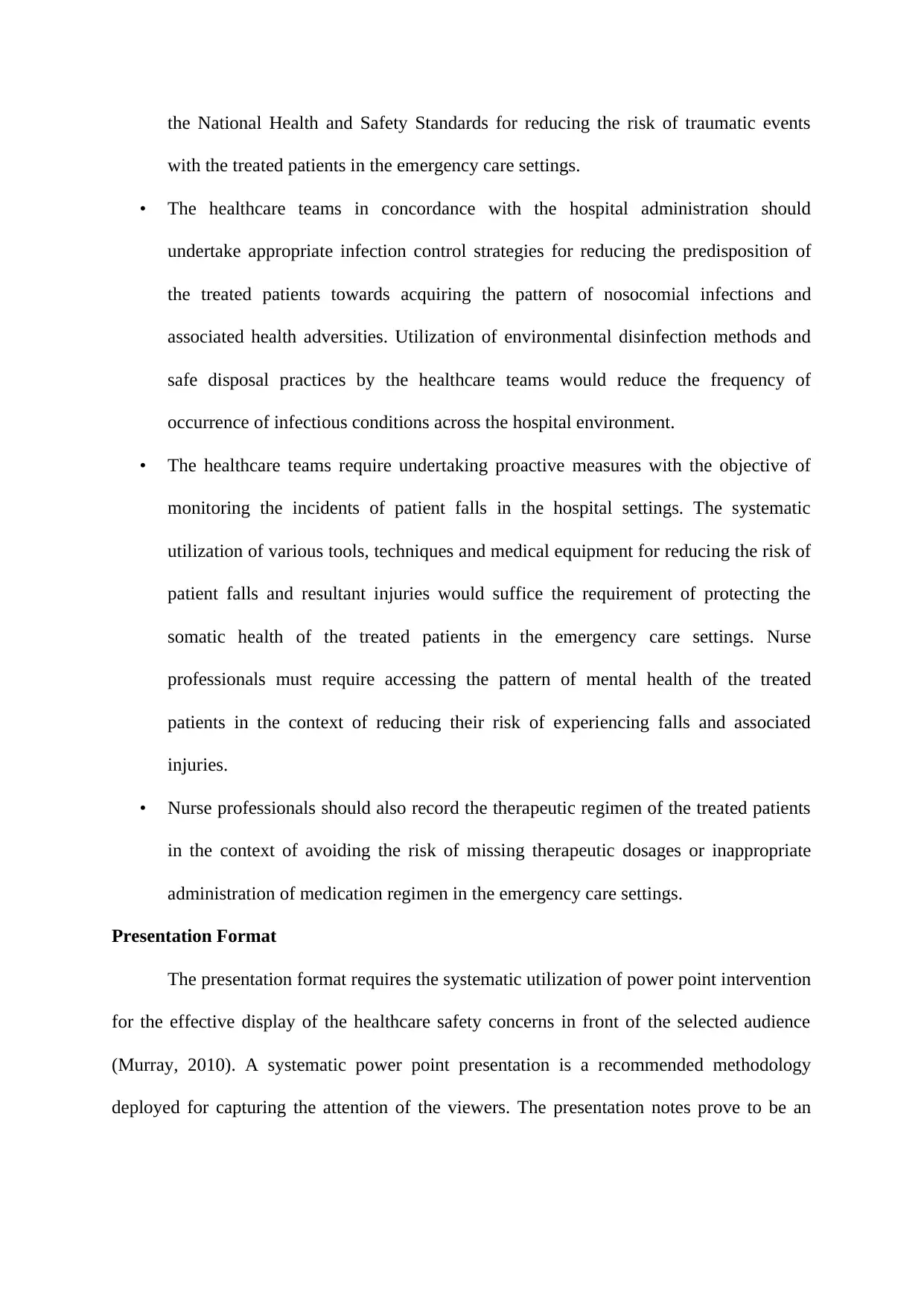
the National Health and Safety Standards for reducing the risk of traumatic events
with the treated patients in the emergency care settings.
• The healthcare teams in concordance with the hospital administration should
undertake appropriate infection control strategies for reducing the predisposition of
the treated patients towards acquiring the pattern of nosocomial infections and
associated health adversities. Utilization of environmental disinfection methods and
safe disposal practices by the healthcare teams would reduce the frequency of
occurrence of infectious conditions across the hospital environment.
• The healthcare teams require undertaking proactive measures with the objective of
monitoring the incidents of patient falls in the hospital settings. The systematic
utilization of various tools, techniques and medical equipment for reducing the risk of
patient falls and resultant injuries would suffice the requirement of protecting the
somatic health of the treated patients in the emergency care settings. Nurse
professionals must require accessing the pattern of mental health of the treated
patients in the context of reducing their risk of experiencing falls and associated
injuries.
• Nurse professionals should also record the therapeutic regimen of the treated patients
in the context of avoiding the risk of missing therapeutic dosages or inappropriate
administration of medication regimen in the emergency care settings.
Presentation Format
The presentation format requires the systematic utilization of power point intervention
for the effective display of the healthcare safety concerns in front of the selected audience
(Murray, 2010). A systematic power point presentation is a recommended methodology
deployed for capturing the attention of the viewers. The presentation notes prove to be an
with the treated patients in the emergency care settings.
• The healthcare teams in concordance with the hospital administration should
undertake appropriate infection control strategies for reducing the predisposition of
the treated patients towards acquiring the pattern of nosocomial infections and
associated health adversities. Utilization of environmental disinfection methods and
safe disposal practices by the healthcare teams would reduce the frequency of
occurrence of infectious conditions across the hospital environment.
• The healthcare teams require undertaking proactive measures with the objective of
monitoring the incidents of patient falls in the hospital settings. The systematic
utilization of various tools, techniques and medical equipment for reducing the risk of
patient falls and resultant injuries would suffice the requirement of protecting the
somatic health of the treated patients in the emergency care settings. Nurse
professionals must require accessing the pattern of mental health of the treated
patients in the context of reducing their risk of experiencing falls and associated
injuries.
• Nurse professionals should also record the therapeutic regimen of the treated patients
in the context of avoiding the risk of missing therapeutic dosages or inappropriate
administration of medication regimen in the emergency care settings.
Presentation Format
The presentation format requires the systematic utilization of power point intervention
for the effective display of the healthcare safety concerns in front of the selected audience
(Murray, 2010). A systematic power point presentation is a recommended methodology
deployed for capturing the attention of the viewers. The presentation notes prove to be an
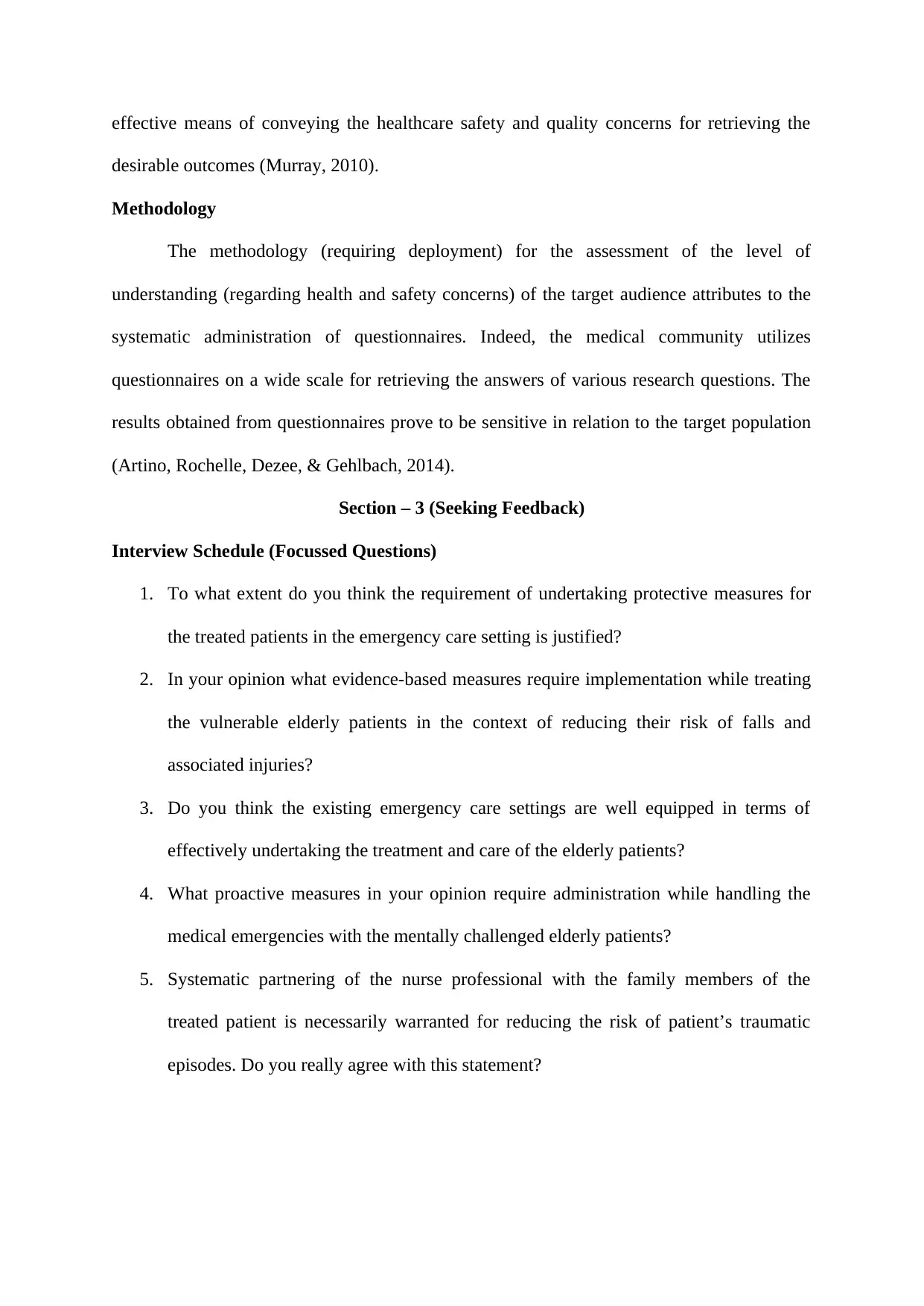
effective means of conveying the healthcare safety and quality concerns for retrieving the
desirable outcomes (Murray, 2010).
Methodology
The methodology (requiring deployment) for the assessment of the level of
understanding (regarding health and safety concerns) of the target audience attributes to the
systematic administration of questionnaires. Indeed, the medical community utilizes
questionnaires on a wide scale for retrieving the answers of various research questions. The
results obtained from questionnaires prove to be sensitive in relation to the target population
(Artino, Rochelle, Dezee, & Gehlbach, 2014).
Section – 3 (Seeking Feedback)
Interview Schedule (Focussed Questions)
1. To what extent do you think the requirement of undertaking protective measures for
the treated patients in the emergency care setting is justified?
2. In your opinion what evidence-based measures require implementation while treating
the vulnerable elderly patients in the context of reducing their risk of falls and
associated injuries?
3. Do you think the existing emergency care settings are well equipped in terms of
effectively undertaking the treatment and care of the elderly patients?
4. What proactive measures in your opinion require administration while handling the
medical emergencies with the mentally challenged elderly patients?
5. Systematic partnering of the nurse professional with the family members of the
treated patient is necessarily warranted for reducing the risk of patient’s traumatic
episodes. Do you really agree with this statement?
desirable outcomes (Murray, 2010).
Methodology
The methodology (requiring deployment) for the assessment of the level of
understanding (regarding health and safety concerns) of the target audience attributes to the
systematic administration of questionnaires. Indeed, the medical community utilizes
questionnaires on a wide scale for retrieving the answers of various research questions. The
results obtained from questionnaires prove to be sensitive in relation to the target population
(Artino, Rochelle, Dezee, & Gehlbach, 2014).
Section – 3 (Seeking Feedback)
Interview Schedule (Focussed Questions)
1. To what extent do you think the requirement of undertaking protective measures for
the treated patients in the emergency care setting is justified?
2. In your opinion what evidence-based measures require implementation while treating
the vulnerable elderly patients in the context of reducing their risk of falls and
associated injuries?
3. Do you think the existing emergency care settings are well equipped in terms of
effectively undertaking the treatment and care of the elderly patients?
4. What proactive measures in your opinion require administration while handling the
medical emergencies with the mentally challenged elderly patients?
5. Systematic partnering of the nurse professional with the family members of the
treated patient is necessarily warranted for reducing the risk of patient’s traumatic
episodes. Do you really agree with this statement?
⊘ This is a preview!⊘
Do you want full access?
Subscribe today to unlock all pages.

Trusted by 1+ million students worldwide
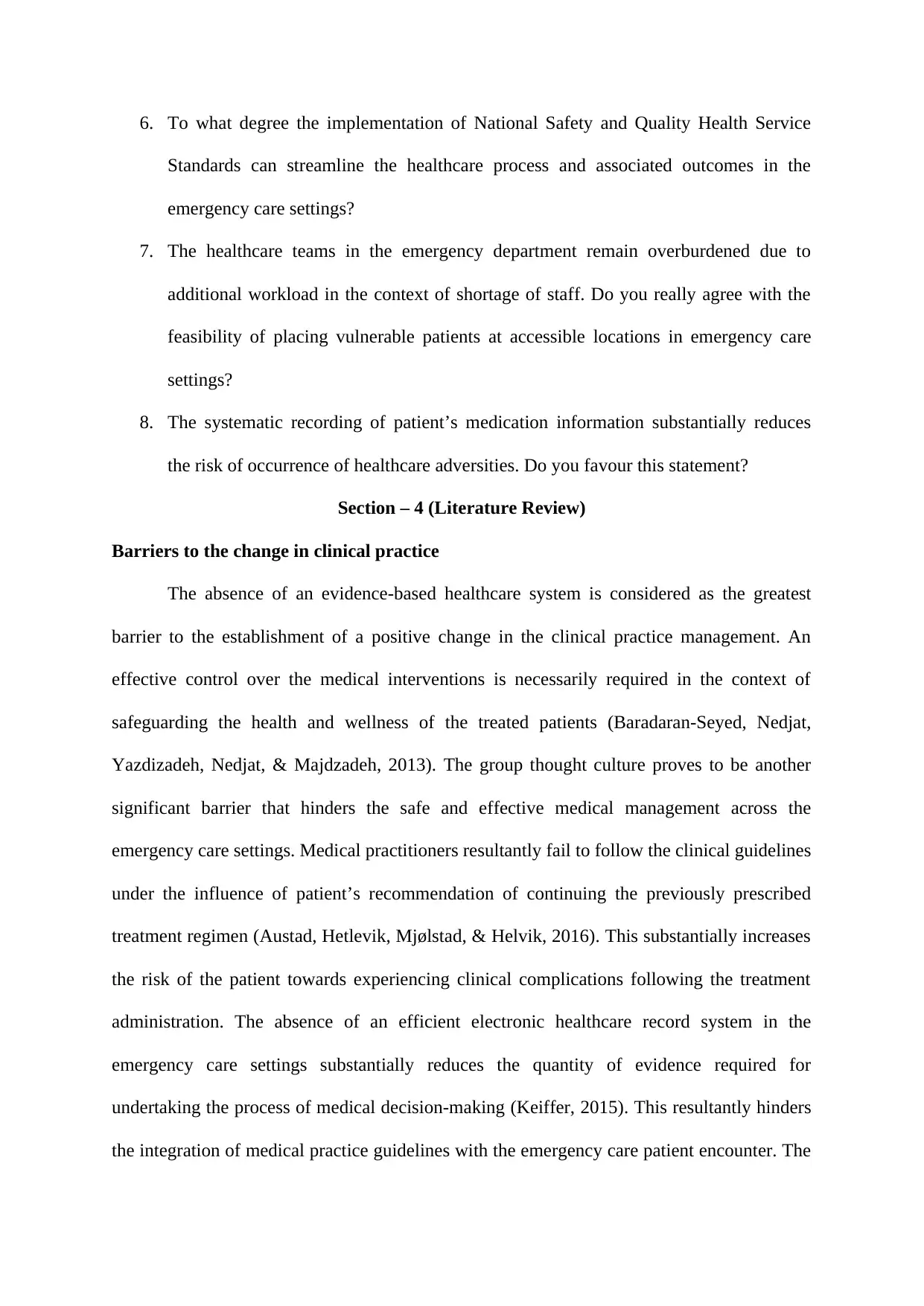
6. To what degree the implementation of National Safety and Quality Health Service
Standards can streamline the healthcare process and associated outcomes in the
emergency care settings?
7. The healthcare teams in the emergency department remain overburdened due to
additional workload in the context of shortage of staff. Do you really agree with the
feasibility of placing vulnerable patients at accessible locations in emergency care
settings?
8. The systematic recording of patient’s medication information substantially reduces
the risk of occurrence of healthcare adversities. Do you favour this statement?
Section – 4 (Literature Review)
Barriers to the change in clinical practice
The absence of an evidence-based healthcare system is considered as the greatest
barrier to the establishment of a positive change in the clinical practice management. An
effective control over the medical interventions is necessarily required in the context of
safeguarding the health and wellness of the treated patients (Baradaran-Seyed, Nedjat,
Yazdizadeh, Nedjat, & Majdzadeh, 2013). The group thought culture proves to be another
significant barrier that hinders the safe and effective medical management across the
emergency care settings. Medical practitioners resultantly fail to follow the clinical guidelines
under the influence of patient’s recommendation of continuing the previously prescribed
treatment regimen (Austad, Hetlevik, Mjølstad, & Helvik, 2016). This substantially increases
the risk of the patient towards experiencing clinical complications following the treatment
administration. The absence of an efficient electronic healthcare record system in the
emergency care settings substantially reduces the quantity of evidence required for
undertaking the process of medical decision-making (Keiffer, 2015). This resultantly hinders
the integration of medical practice guidelines with the emergency care patient encounter. The
Standards can streamline the healthcare process and associated outcomes in the
emergency care settings?
7. The healthcare teams in the emergency department remain overburdened due to
additional workload in the context of shortage of staff. Do you really agree with the
feasibility of placing vulnerable patients at accessible locations in emergency care
settings?
8. The systematic recording of patient’s medication information substantially reduces
the risk of occurrence of healthcare adversities. Do you favour this statement?
Section – 4 (Literature Review)
Barriers to the change in clinical practice
The absence of an evidence-based healthcare system is considered as the greatest
barrier to the establishment of a positive change in the clinical practice management. An
effective control over the medical interventions is necessarily required in the context of
safeguarding the health and wellness of the treated patients (Baradaran-Seyed, Nedjat,
Yazdizadeh, Nedjat, & Majdzadeh, 2013). The group thought culture proves to be another
significant barrier that hinders the safe and effective medical management across the
emergency care settings. Medical practitioners resultantly fail to follow the clinical guidelines
under the influence of patient’s recommendation of continuing the previously prescribed
treatment regimen (Austad, Hetlevik, Mjølstad, & Helvik, 2016). This substantially increases
the risk of the patient towards experiencing clinical complications following the treatment
administration. The absence of an efficient electronic healthcare record system in the
emergency care settings substantially reduces the quantity of evidence required for
undertaking the process of medical decision-making (Keiffer, 2015). This resultantly hinders
the integration of medical practice guidelines with the emergency care patient encounter. The
Paraphrase This Document
Need a fresh take? Get an instant paraphrase of this document with our AI Paraphraser
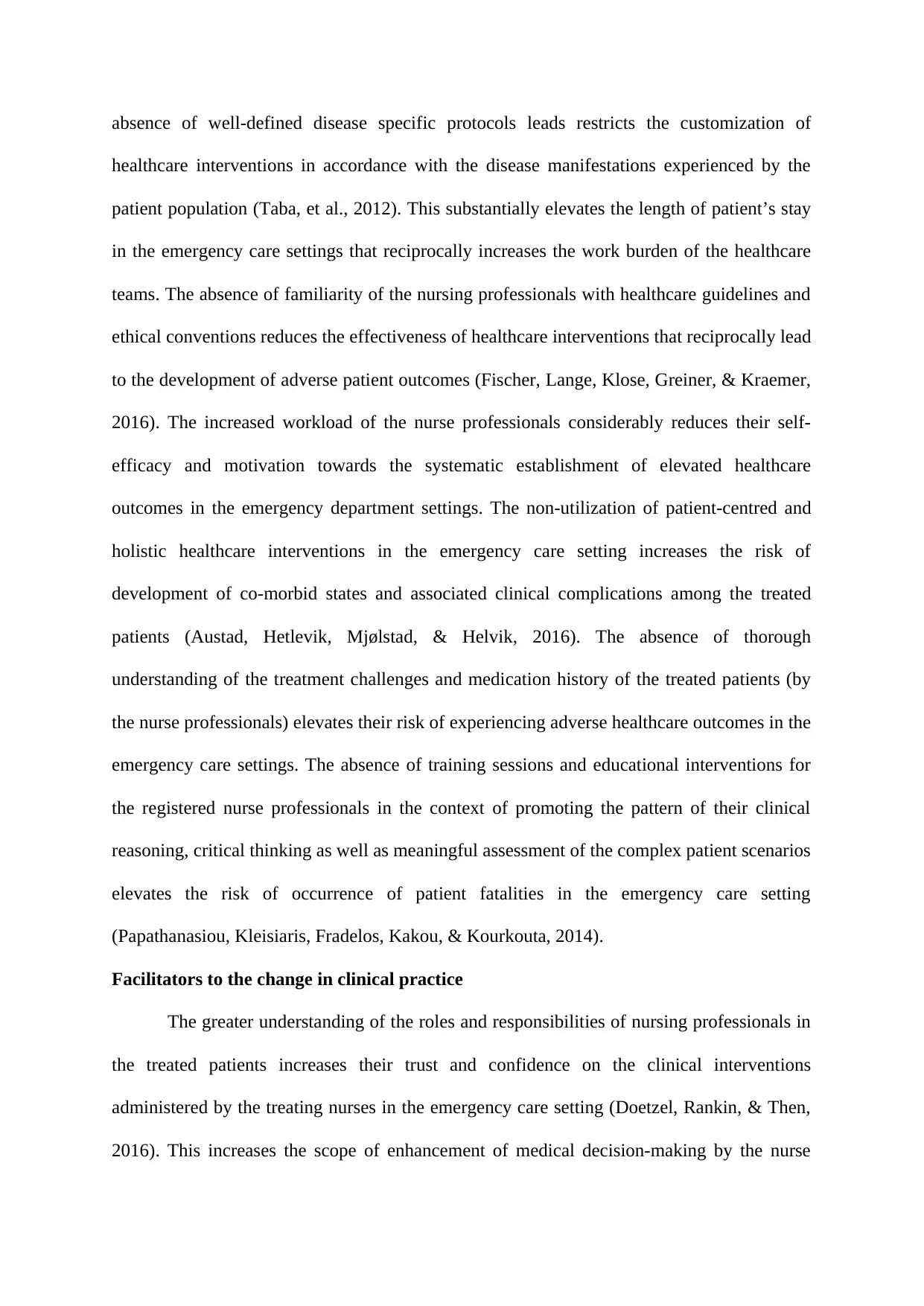
absence of well-defined disease specific protocols leads restricts the customization of
healthcare interventions in accordance with the disease manifestations experienced by the
patient population (Taba, et al., 2012). This substantially elevates the length of patient’s stay
in the emergency care settings that reciprocally increases the work burden of the healthcare
teams. The absence of familiarity of the nursing professionals with healthcare guidelines and
ethical conventions reduces the effectiveness of healthcare interventions that reciprocally lead
to the development of adverse patient outcomes (Fischer, Lange, Klose, Greiner, & Kraemer,
2016). The increased workload of the nurse professionals considerably reduces their self-
efficacy and motivation towards the systematic establishment of elevated healthcare
outcomes in the emergency department settings. The non-utilization of patient-centred and
holistic healthcare interventions in the emergency care setting increases the risk of
development of co-morbid states and associated clinical complications among the treated
patients (Austad, Hetlevik, Mjølstad, & Helvik, 2016). The absence of thorough
understanding of the treatment challenges and medication history of the treated patients (by
the nurse professionals) elevates their risk of experiencing adverse healthcare outcomes in the
emergency care settings. The absence of training sessions and educational interventions for
the registered nurse professionals in the context of promoting the pattern of their clinical
reasoning, critical thinking as well as meaningful assessment of the complex patient scenarios
elevates the risk of occurrence of patient fatalities in the emergency care setting
(Papathanasiou, Kleisiaris, Fradelos, Kakou, & Kourkouta, 2014).
Facilitators to the change in clinical practice
The greater understanding of the roles and responsibilities of nursing professionals in
the treated patients increases their trust and confidence on the clinical interventions
administered by the treating nurses in the emergency care setting (Doetzel, Rankin, & Then,
2016). This increases the scope of enhancement of medical decision-making by the nurse
healthcare interventions in accordance with the disease manifestations experienced by the
patient population (Taba, et al., 2012). This substantially elevates the length of patient’s stay
in the emergency care settings that reciprocally increases the work burden of the healthcare
teams. The absence of familiarity of the nursing professionals with healthcare guidelines and
ethical conventions reduces the effectiveness of healthcare interventions that reciprocally lead
to the development of adverse patient outcomes (Fischer, Lange, Klose, Greiner, & Kraemer,
2016). The increased workload of the nurse professionals considerably reduces their self-
efficacy and motivation towards the systematic establishment of elevated healthcare
outcomes in the emergency department settings. The non-utilization of patient-centred and
holistic healthcare interventions in the emergency care setting increases the risk of
development of co-morbid states and associated clinical complications among the treated
patients (Austad, Hetlevik, Mjølstad, & Helvik, 2016). The absence of thorough
understanding of the treatment challenges and medication history of the treated patients (by
the nurse professionals) elevates their risk of experiencing adverse healthcare outcomes in the
emergency care settings. The absence of training sessions and educational interventions for
the registered nurse professionals in the context of promoting the pattern of their clinical
reasoning, critical thinking as well as meaningful assessment of the complex patient scenarios
elevates the risk of occurrence of patient fatalities in the emergency care setting
(Papathanasiou, Kleisiaris, Fradelos, Kakou, & Kourkouta, 2014).
Facilitators to the change in clinical practice
The greater understanding of the roles and responsibilities of nursing professionals in
the treated patients increases their trust and confidence on the clinical interventions
administered by the treating nurses in the emergency care setting (Doetzel, Rankin, & Then,
2016). This increases the scope of enhancement of medical decision-making by the nurse
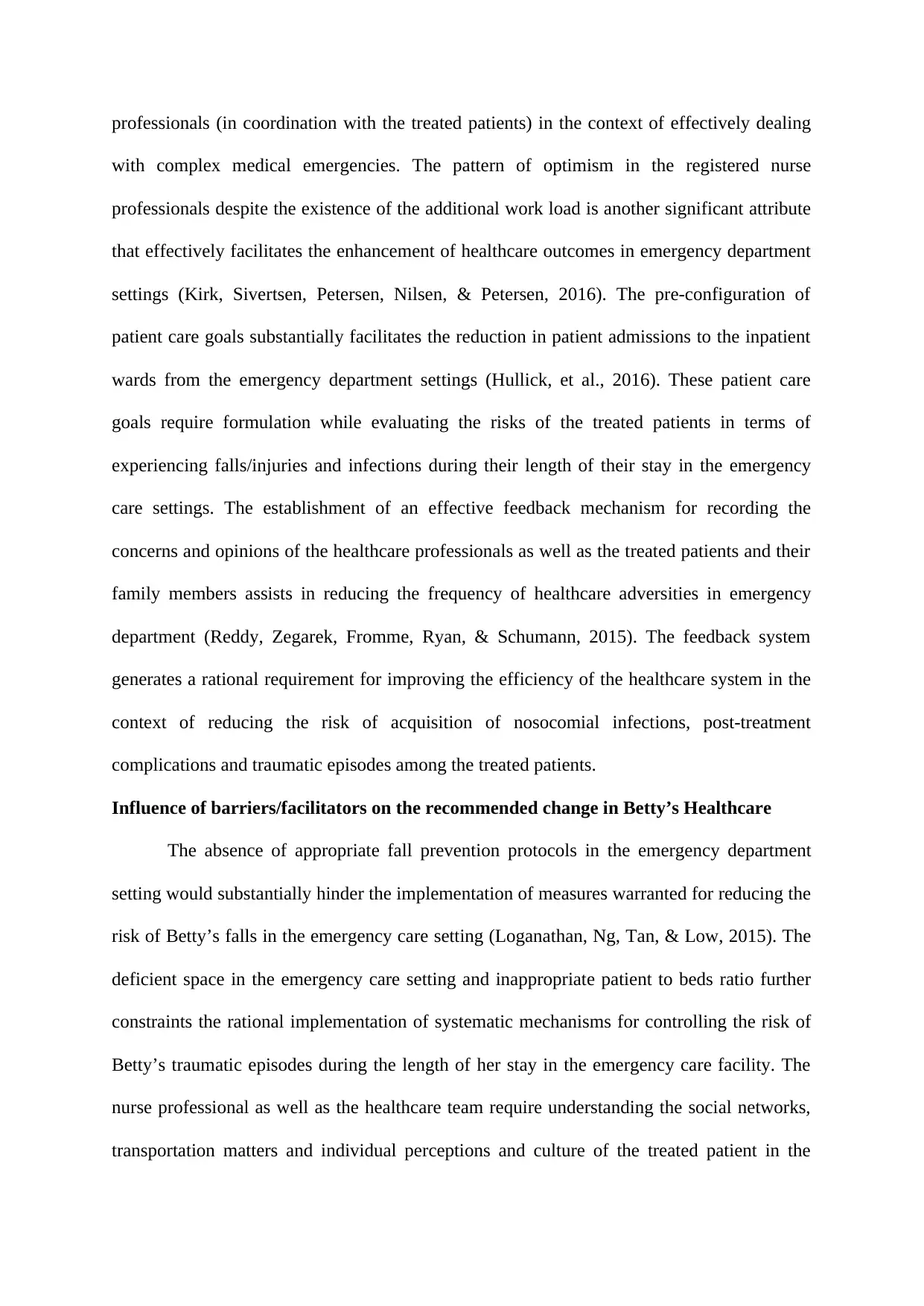
professionals (in coordination with the treated patients) in the context of effectively dealing
with complex medical emergencies. The pattern of optimism in the registered nurse
professionals despite the existence of the additional work load is another significant attribute
that effectively facilitates the enhancement of healthcare outcomes in emergency department
settings (Kirk, Sivertsen, Petersen, Nilsen, & Petersen, 2016). The pre-configuration of
patient care goals substantially facilitates the reduction in patient admissions to the inpatient
wards from the emergency department settings (Hullick, et al., 2016). These patient care
goals require formulation while evaluating the risks of the treated patients in terms of
experiencing falls/injuries and infections during their length of their stay in the emergency
care settings. The establishment of an effective feedback mechanism for recording the
concerns and opinions of the healthcare professionals as well as the treated patients and their
family members assists in reducing the frequency of healthcare adversities in emergency
department (Reddy, Zegarek, Fromme, Ryan, & Schumann, 2015). The feedback system
generates a rational requirement for improving the efficiency of the healthcare system in the
context of reducing the risk of acquisition of nosocomial infections, post-treatment
complications and traumatic episodes among the treated patients.
Influence of barriers/facilitators on the recommended change in Betty’s Healthcare
The absence of appropriate fall prevention protocols in the emergency department
setting would substantially hinder the implementation of measures warranted for reducing the
risk of Betty’s falls in the emergency care setting (Loganathan, Ng, Tan, & Low, 2015). The
deficient space in the emergency care setting and inappropriate patient to beds ratio further
constraints the rational implementation of systematic mechanisms for controlling the risk of
Betty’s traumatic episodes during the length of her stay in the emergency care facility. The
nurse professional as well as the healthcare team require understanding the social networks,
transportation matters and individual perceptions and culture of the treated patient in the
with complex medical emergencies. The pattern of optimism in the registered nurse
professionals despite the existence of the additional work load is another significant attribute
that effectively facilitates the enhancement of healthcare outcomes in emergency department
settings (Kirk, Sivertsen, Petersen, Nilsen, & Petersen, 2016). The pre-configuration of
patient care goals substantially facilitates the reduction in patient admissions to the inpatient
wards from the emergency department settings (Hullick, et al., 2016). These patient care
goals require formulation while evaluating the risks of the treated patients in terms of
experiencing falls/injuries and infections during their length of their stay in the emergency
care settings. The establishment of an effective feedback mechanism for recording the
concerns and opinions of the healthcare professionals as well as the treated patients and their
family members assists in reducing the frequency of healthcare adversities in emergency
department (Reddy, Zegarek, Fromme, Ryan, & Schumann, 2015). The feedback system
generates a rational requirement for improving the efficiency of the healthcare system in the
context of reducing the risk of acquisition of nosocomial infections, post-treatment
complications and traumatic episodes among the treated patients.
Influence of barriers/facilitators on the recommended change in Betty’s Healthcare
The absence of appropriate fall prevention protocols in the emergency department
setting would substantially hinder the implementation of measures warranted for reducing the
risk of Betty’s falls in the emergency care setting (Loganathan, Ng, Tan, & Low, 2015). The
deficient space in the emergency care setting and inappropriate patient to beds ratio further
constraints the rational implementation of systematic mechanisms for controlling the risk of
Betty’s traumatic episodes during the length of her stay in the emergency care facility. The
nurse professional as well as the healthcare team require understanding the social networks,
transportation matters and individual perceptions and culture of the treated patient in the
⊘ This is a preview!⊘
Do you want full access?
Subscribe today to unlock all pages.

Trusted by 1+ million students worldwide
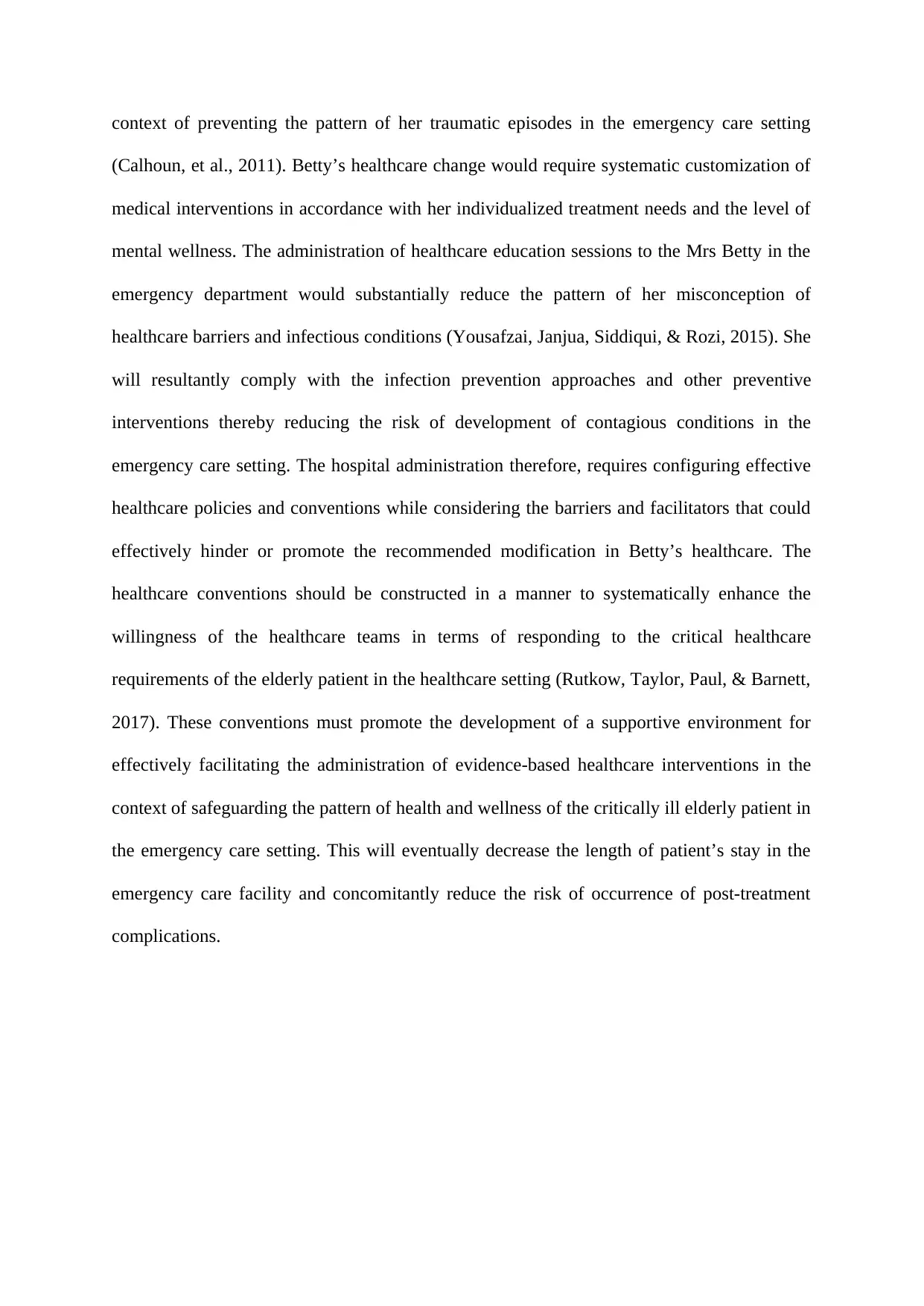
context of preventing the pattern of her traumatic episodes in the emergency care setting
(Calhoun, et al., 2011). Betty’s healthcare change would require systematic customization of
medical interventions in accordance with her individualized treatment needs and the level of
mental wellness. The administration of healthcare education sessions to the Mrs Betty in the
emergency department would substantially reduce the pattern of her misconception of
healthcare barriers and infectious conditions (Yousafzai, Janjua, Siddiqui, & Rozi, 2015). She
will resultantly comply with the infection prevention approaches and other preventive
interventions thereby reducing the risk of development of contagious conditions in the
emergency care setting. The hospital administration therefore, requires configuring effective
healthcare policies and conventions while considering the barriers and facilitators that could
effectively hinder or promote the recommended modification in Betty’s healthcare. The
healthcare conventions should be constructed in a manner to systematically enhance the
willingness of the healthcare teams in terms of responding to the critical healthcare
requirements of the elderly patient in the healthcare setting (Rutkow, Taylor, Paul, & Barnett,
2017). These conventions must promote the development of a supportive environment for
effectively facilitating the administration of evidence-based healthcare interventions in the
context of safeguarding the pattern of health and wellness of the critically ill elderly patient in
the emergency care setting. This will eventually decrease the length of patient’s stay in the
emergency care facility and concomitantly reduce the risk of occurrence of post-treatment
complications.
(Calhoun, et al., 2011). Betty’s healthcare change would require systematic customization of
medical interventions in accordance with her individualized treatment needs and the level of
mental wellness. The administration of healthcare education sessions to the Mrs Betty in the
emergency department would substantially reduce the pattern of her misconception of
healthcare barriers and infectious conditions (Yousafzai, Janjua, Siddiqui, & Rozi, 2015). She
will resultantly comply with the infection prevention approaches and other preventive
interventions thereby reducing the risk of development of contagious conditions in the
emergency care setting. The hospital administration therefore, requires configuring effective
healthcare policies and conventions while considering the barriers and facilitators that could
effectively hinder or promote the recommended modification in Betty’s healthcare. The
healthcare conventions should be constructed in a manner to systematically enhance the
willingness of the healthcare teams in terms of responding to the critical healthcare
requirements of the elderly patient in the healthcare setting (Rutkow, Taylor, Paul, & Barnett,
2017). These conventions must promote the development of a supportive environment for
effectively facilitating the administration of evidence-based healthcare interventions in the
context of safeguarding the pattern of health and wellness of the critically ill elderly patient in
the emergency care setting. This will eventually decrease the length of patient’s stay in the
emergency care facility and concomitantly reduce the risk of occurrence of post-treatment
complications.
Paraphrase This Document
Need a fresh take? Get an instant paraphrase of this document with our AI Paraphraser
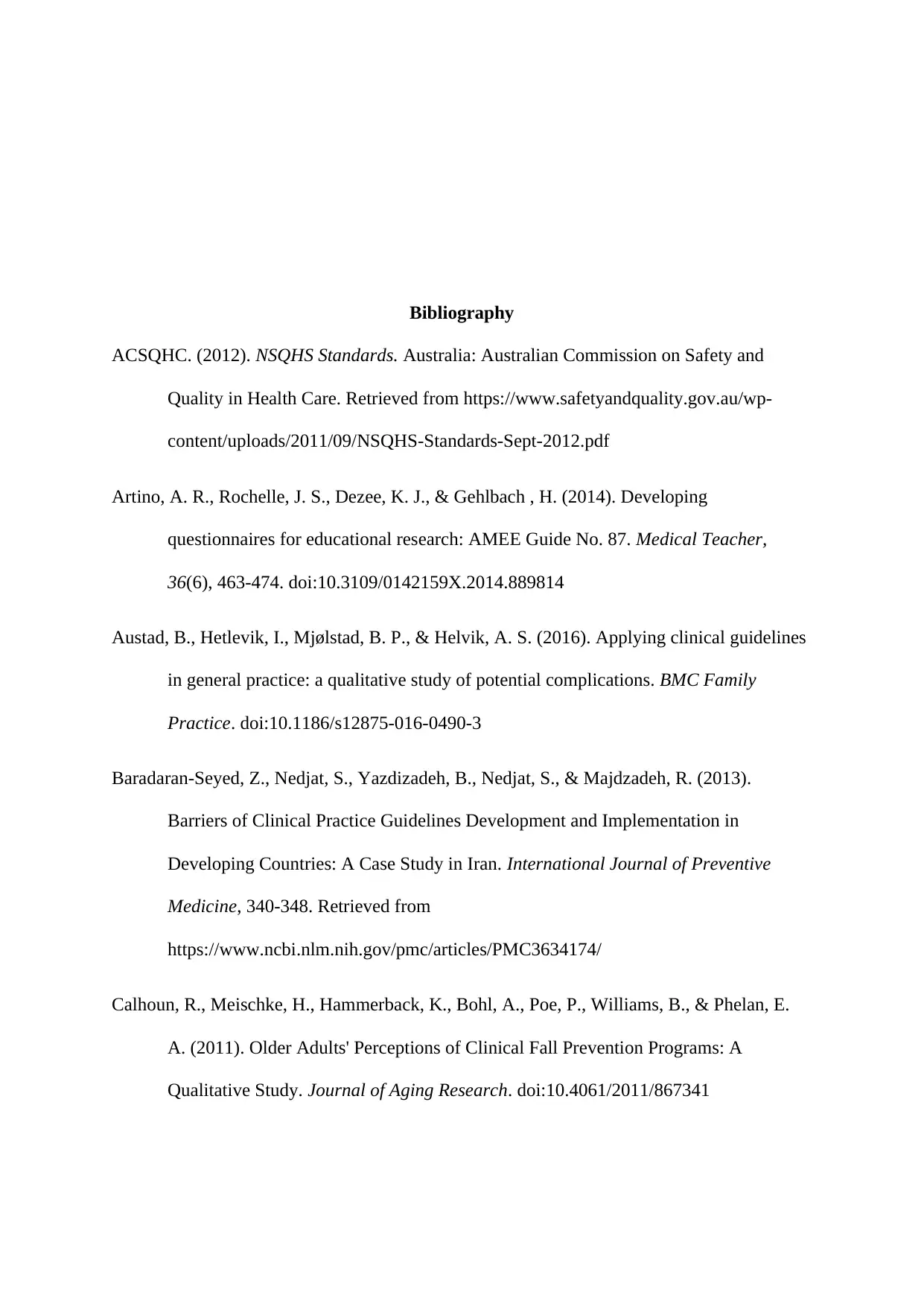
Bibliography
ACSQHC. (2012). NSQHS Standards. Australia: Australian Commission on Safety and
Quality in Health Care. Retrieved from https://www.safetyandquality.gov.au/wp-
content/uploads/2011/09/NSQHS-Standards-Sept-2012.pdf
Artino, A. R., Rochelle, J. S., Dezee, K. J., & Gehlbach , H. (2014). Developing
questionnaires for educational research: AMEE Guide No. 87. Medical Teacher,
36(6), 463-474. doi:10.3109/0142159X.2014.889814
Austad, B., Hetlevik, I., Mjølstad, B. P., & Helvik, A. S. (2016). Applying clinical guidelines
in general practice: a qualitative study of potential complications. BMC Family
Practice. doi:10.1186/s12875-016-0490-3
Baradaran-Seyed, Z., Nedjat, S., Yazdizadeh, B., Nedjat, S., & Majdzadeh, R. (2013).
Barriers of Clinical Practice Guidelines Development and Implementation in
Developing Countries: A Case Study in Iran. International Journal of Preventive
Medicine, 340-348. Retrieved from
https://www.ncbi.nlm.nih.gov/pmc/articles/PMC3634174/
Calhoun, R., Meischke, H., Hammerback, K., Bohl, A., Poe, P., Williams, B., & Phelan, E.
A. (2011). Older Adults' Perceptions of Clinical Fall Prevention Programs: A
Qualitative Study. Journal of Aging Research. doi:10.4061/2011/867341
ACSQHC. (2012). NSQHS Standards. Australia: Australian Commission on Safety and
Quality in Health Care. Retrieved from https://www.safetyandquality.gov.au/wp-
content/uploads/2011/09/NSQHS-Standards-Sept-2012.pdf
Artino, A. R., Rochelle, J. S., Dezee, K. J., & Gehlbach , H. (2014). Developing
questionnaires for educational research: AMEE Guide No. 87. Medical Teacher,
36(6), 463-474. doi:10.3109/0142159X.2014.889814
Austad, B., Hetlevik, I., Mjølstad, B. P., & Helvik, A. S. (2016). Applying clinical guidelines
in general practice: a qualitative study of potential complications. BMC Family
Practice. doi:10.1186/s12875-016-0490-3
Baradaran-Seyed, Z., Nedjat, S., Yazdizadeh, B., Nedjat, S., & Majdzadeh, R. (2013).
Barriers of Clinical Practice Guidelines Development and Implementation in
Developing Countries: A Case Study in Iran. International Journal of Preventive
Medicine, 340-348. Retrieved from
https://www.ncbi.nlm.nih.gov/pmc/articles/PMC3634174/
Calhoun, R., Meischke, H., Hammerback, K., Bohl, A., Poe, P., Williams, B., & Phelan, E.
A. (2011). Older Adults' Perceptions of Clinical Fall Prevention Programs: A
Qualitative Study. Journal of Aging Research. doi:10.4061/2011/867341
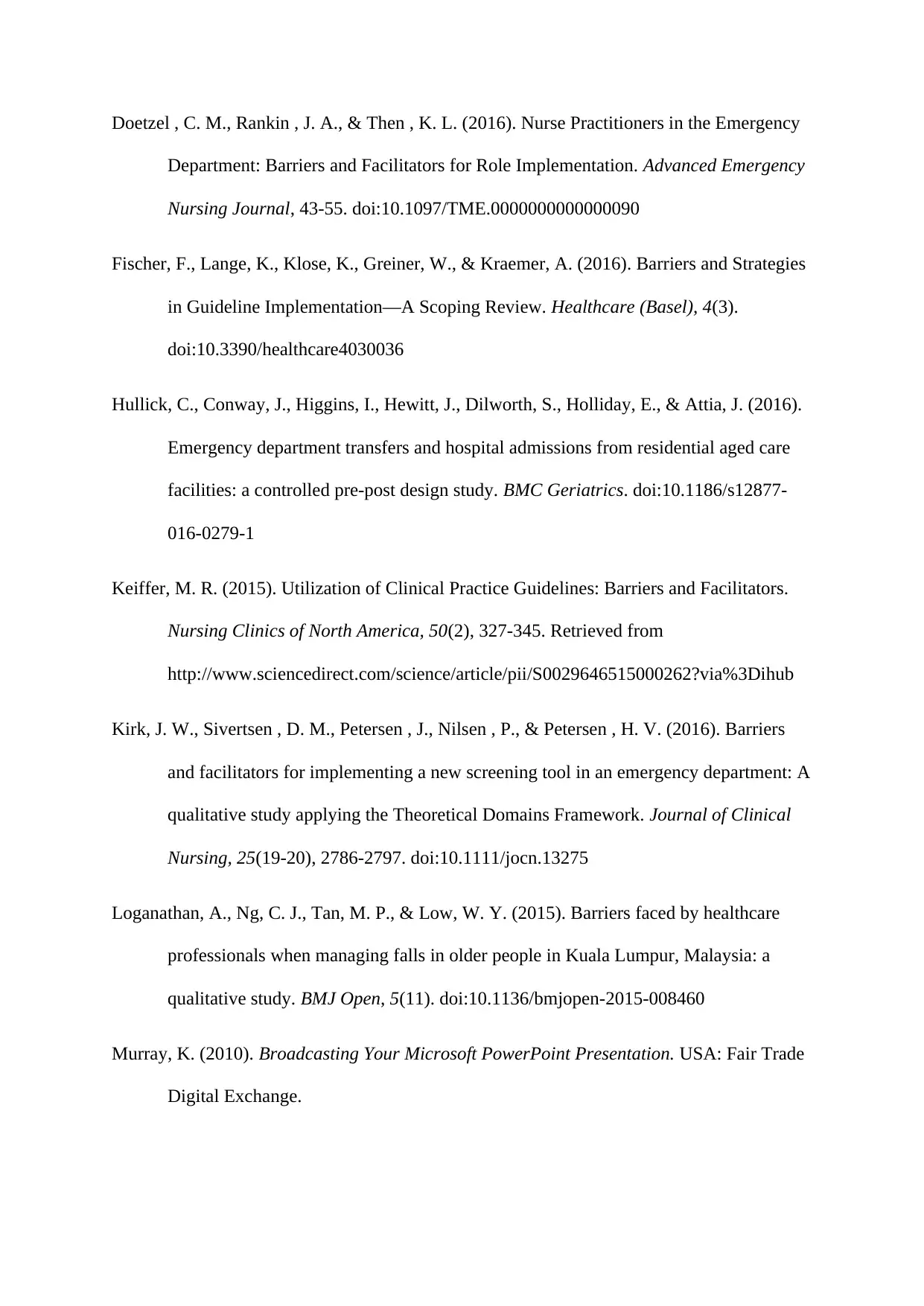
Doetzel , C. M., Rankin , J. A., & Then , K. L. (2016). Nurse Practitioners in the Emergency
Department: Barriers and Facilitators for Role Implementation. Advanced Emergency
Nursing Journal, 43-55. doi:10.1097/TME.0000000000000090
Fischer, F., Lange, K., Klose, K., Greiner, W., & Kraemer, A. (2016). Barriers and Strategies
in Guideline Implementation—A Scoping Review. Healthcare (Basel), 4(3).
doi:10.3390/healthcare4030036
Hullick, C., Conway, J., Higgins, I., Hewitt, J., Dilworth, S., Holliday, E., & Attia, J. (2016).
Emergency department transfers and hospital admissions from residential aged care
facilities: a controlled pre-post design study. BMC Geriatrics. doi:10.1186/s12877-
016-0279-1
Keiffer, M. R. (2015). Utilization of Clinical Practice Guidelines: Barriers and Facilitators.
Nursing Clinics of North America, 50(2), 327-345. Retrieved from
http://www.sciencedirect.com/science/article/pii/S0029646515000262?via%3Dihub
Kirk, J. W., Sivertsen , D. M., Petersen , J., Nilsen , P., & Petersen , H. V. (2016). Barriers
and facilitators for implementing a new screening tool in an emergency department: A
qualitative study applying the Theoretical Domains Framework. Journal of Clinical
Nursing, 25(19-20), 2786-2797. doi:10.1111/jocn.13275
Loganathan, A., Ng, C. J., Tan, M. P., & Low, W. Y. (2015). Barriers faced by healthcare
professionals when managing falls in older people in Kuala Lumpur, Malaysia: a
qualitative study. BMJ Open, 5(11). doi:10.1136/bmjopen-2015-008460
Murray, K. (2010). Broadcasting Your Microsoft PowerPoint Presentation. USA: Fair Trade
Digital Exchange.
Department: Barriers and Facilitators for Role Implementation. Advanced Emergency
Nursing Journal, 43-55. doi:10.1097/TME.0000000000000090
Fischer, F., Lange, K., Klose, K., Greiner, W., & Kraemer, A. (2016). Barriers and Strategies
in Guideline Implementation—A Scoping Review. Healthcare (Basel), 4(3).
doi:10.3390/healthcare4030036
Hullick, C., Conway, J., Higgins, I., Hewitt, J., Dilworth, S., Holliday, E., & Attia, J. (2016).
Emergency department transfers and hospital admissions from residential aged care
facilities: a controlled pre-post design study. BMC Geriatrics. doi:10.1186/s12877-
016-0279-1
Keiffer, M. R. (2015). Utilization of Clinical Practice Guidelines: Barriers and Facilitators.
Nursing Clinics of North America, 50(2), 327-345. Retrieved from
http://www.sciencedirect.com/science/article/pii/S0029646515000262?via%3Dihub
Kirk, J. W., Sivertsen , D. M., Petersen , J., Nilsen , P., & Petersen , H. V. (2016). Barriers
and facilitators for implementing a new screening tool in an emergency department: A
qualitative study applying the Theoretical Domains Framework. Journal of Clinical
Nursing, 25(19-20), 2786-2797. doi:10.1111/jocn.13275
Loganathan, A., Ng, C. J., Tan, M. P., & Low, W. Y. (2015). Barriers faced by healthcare
professionals when managing falls in older people in Kuala Lumpur, Malaysia: a
qualitative study. BMJ Open, 5(11). doi:10.1136/bmjopen-2015-008460
Murray, K. (2010). Broadcasting Your Microsoft PowerPoint Presentation. USA: Fair Trade
Digital Exchange.
⊘ This is a preview!⊘
Do you want full access?
Subscribe today to unlock all pages.

Trusted by 1+ million students worldwide
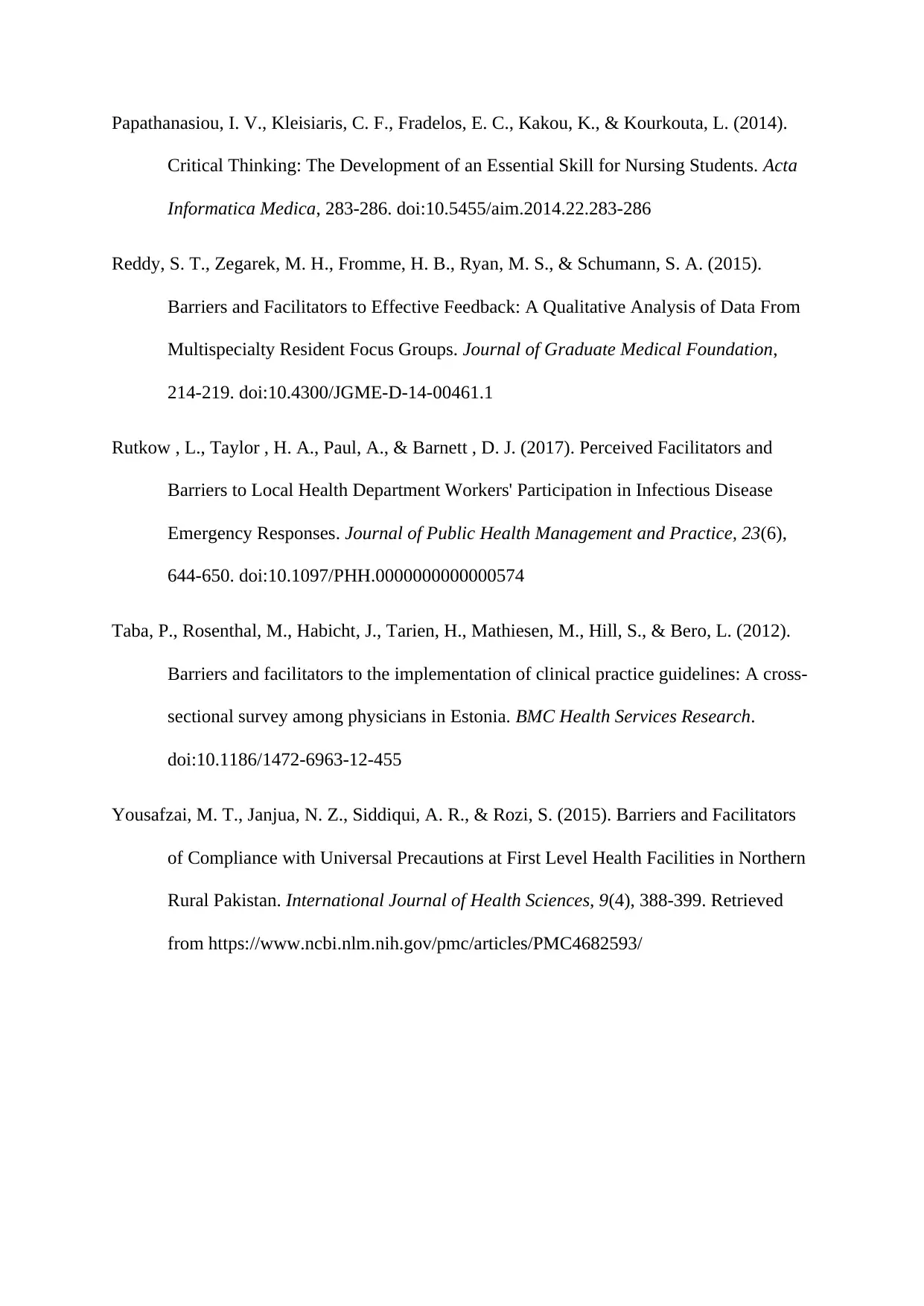
Papathanasiou, I. V., Kleisiaris, C. F., Fradelos, E. C., Kakou, K., & Kourkouta, L. (2014).
Critical Thinking: The Development of an Essential Skill for Nursing Students. Acta
Informatica Medica, 283-286. doi:10.5455/aim.2014.22.283-286
Reddy, S. T., Zegarek, M. H., Fromme, H. B., Ryan, M. S., & Schumann, S. A. (2015).
Barriers and Facilitators to Effective Feedback: A Qualitative Analysis of Data From
Multispecialty Resident Focus Groups. Journal of Graduate Medical Foundation,
214-219. doi:10.4300/JGME-D-14-00461.1
Rutkow , L., Taylor , H. A., Paul, A., & Barnett , D. J. (2017). Perceived Facilitators and
Barriers to Local Health Department Workers' Participation in Infectious Disease
Emergency Responses. Journal of Public Health Management and Practice, 23(6),
644-650. doi:10.1097/PHH.0000000000000574
Taba, P., Rosenthal, M., Habicht, J., Tarien, H., Mathiesen, M., Hill, S., & Bero, L. (2012).
Barriers and facilitators to the implementation of clinical practice guidelines: A cross-
sectional survey among physicians in Estonia. BMC Health Services Research.
doi:10.1186/1472-6963-12-455
Yousafzai, M. T., Janjua, N. Z., Siddiqui, A. R., & Rozi, S. (2015). Barriers and Facilitators
of Compliance with Universal Precautions at First Level Health Facilities in Northern
Rural Pakistan. International Journal of Health Sciences, 9(4), 388-399. Retrieved
from https://www.ncbi.nlm.nih.gov/pmc/articles/PMC4682593/
Critical Thinking: The Development of an Essential Skill for Nursing Students. Acta
Informatica Medica, 283-286. doi:10.5455/aim.2014.22.283-286
Reddy, S. T., Zegarek, M. H., Fromme, H. B., Ryan, M. S., & Schumann, S. A. (2015).
Barriers and Facilitators to Effective Feedback: A Qualitative Analysis of Data From
Multispecialty Resident Focus Groups. Journal of Graduate Medical Foundation,
214-219. doi:10.4300/JGME-D-14-00461.1
Rutkow , L., Taylor , H. A., Paul, A., & Barnett , D. J. (2017). Perceived Facilitators and
Barriers to Local Health Department Workers' Participation in Infectious Disease
Emergency Responses. Journal of Public Health Management and Practice, 23(6),
644-650. doi:10.1097/PHH.0000000000000574
Taba, P., Rosenthal, M., Habicht, J., Tarien, H., Mathiesen, M., Hill, S., & Bero, L. (2012).
Barriers and facilitators to the implementation of clinical practice guidelines: A cross-
sectional survey among physicians in Estonia. BMC Health Services Research.
doi:10.1186/1472-6963-12-455
Yousafzai, M. T., Janjua, N. Z., Siddiqui, A. R., & Rozi, S. (2015). Barriers and Facilitators
of Compliance with Universal Precautions at First Level Health Facilities in Northern
Rural Pakistan. International Journal of Health Sciences, 9(4), 388-399. Retrieved
from https://www.ncbi.nlm.nih.gov/pmc/articles/PMC4682593/
1 out of 10
Related Documents
Your All-in-One AI-Powered Toolkit for Academic Success.
+13062052269
info@desklib.com
Available 24*7 on WhatsApp / Email
![[object Object]](/_next/static/media/star-bottom.7253800d.svg)
Unlock your academic potential
© 2024 | Zucol Services PVT LTD | All rights reserved.





